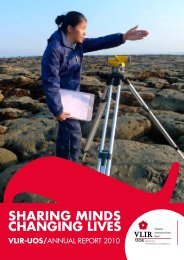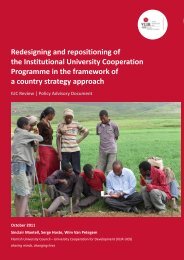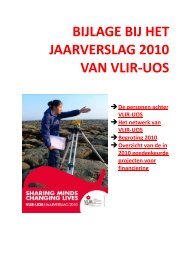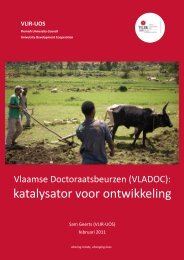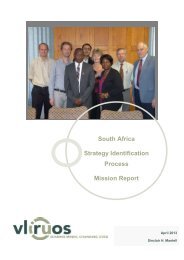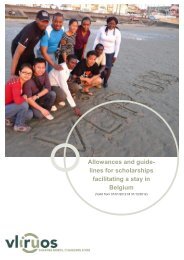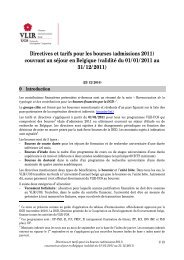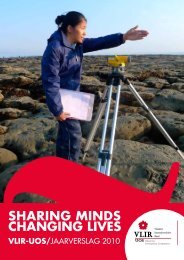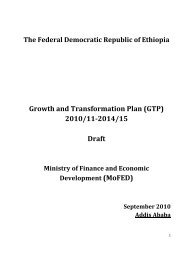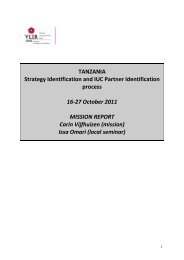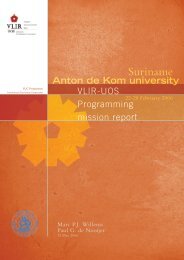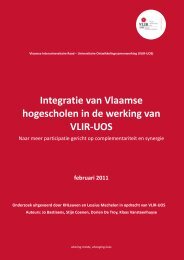Education Sector Development Program - VLIR-UOS
Education Sector Development Program - VLIR-UOS
Education Sector Development Program - VLIR-UOS
You also want an ePaper? Increase the reach of your titles
YUMPU automatically turns print PDFs into web optimized ePapers that Google loves.
<strong>Education</strong> <strong>Sector</strong> <strong>Development</strong> <strong>Program</strong> IV<br />
Up-grading the academic level of REB and WEO<br />
officials and experts of the emerging regions by<br />
arranging:<br />
In-service summer programs<br />
Distance programs, etc.<br />
Number of WEO staffs up-graded from certificate<br />
to diploma<br />
Number of WEO staffs upgraded from Diploma to<br />
Degree<br />
Number of REB staffs up-graded from certificate<br />
to diploma<br />
Number of REB staffs up-graded from diploma to<br />
Degree and above<br />
Number of WEO supervisors up-graded from<br />
certificate to diploma<br />
Number of WEO supervisors up-graded from<br />
diploma to Degree<br />
School Water, Sanitation & Hygiene<br />
(WASH)<br />
1. Situation analysis<br />
WASH (Water sanitation & hygiene) in<br />
schools is a major problem in many countries<br />
contributing to a high disease prevalence, poor<br />
learning environments and impacting on girls’<br />
education. Children should be seen as agents<br />
of change for WASH within their schools,<br />
communities and homes. Water supply and<br />
sanitation facilities in schools, coupled with the<br />
promotion of hygiene, have a great influence<br />
on the quality of education.<br />
The Ministry of <strong>Education</strong> Annual Abstract<br />
(2007/8) indicates that the latrine coverage<br />
in primary schools is about 90.6% and water<br />
supply coverage is 30.2%. The latrine coverage<br />
in high schools is 100% and water supply<br />
coverage is 67.9%. The abstract doesn’t show<br />
the functionality or level of service provided of<br />
the schemes. In 2006, UNICEF undertook a<br />
detailed survey of the WASH status of primary<br />
schools. It was found that 22% of the 2,013<br />
schools surveyed had a protected water supply<br />
in the compound. In many cases, the quantity<br />
of water available was deemed insufficient,<br />
based on a norm of 5 litres per capita day.<br />
The physical accessibility of water sources<br />
is a concern as about 50% of schools were<br />
more than 1 km of travel time. Hand washing<br />
facilities, including water and soap, are not<br />
available in schools.<br />
76% of the schools surveyed had some sort of<br />
latrine. Of these, 65% had separate facilities<br />
for girls and boys (mostly with a common wall).<br />
Only, 38% of the toilets surveyed were assessed<br />
to be in a clean condition. Hand washing<br />
facilities were found in only 4% of the schools<br />
with latrines, even less featured urinals. 56%<br />
of schools had an apparently active sanitation<br />
club. One way or another, hygiene education<br />
was imparted to students in just under half the<br />
schools. There are problems with the designs<br />
being used (referring to toilet blocks, urinals,<br />
hand washing facilities and waste water<br />
management), their location, orientation and<br />
cost. Designs do not reflect gender concerns<br />
(for example, associated with menstruation),<br />
nor the associated need for privacy and<br />
security, nor the special needs of physically<br />
challenged students. More fundamentally,<br />
little emphasis is given to the use, upkeep,<br />
maintenance and management of sanitation<br />
facilities, and the hygiene education and<br />
promotion needed to ensure their use and the<br />
adoption of other hygiene practices.<br />
Main Challenges<br />
• The drinking water coverage<br />
at primary school is estimated<br />
to be 32.3%, which is very low<br />
compared to the national one.<br />
• The quantity of water in schools<br />
where there is a supply was<br />
found to be inadequate, even not<br />
satisfying the minimum needs,<br />
at least of 5 liters per day per<br />
capita.<br />
• The physical accessibility of<br />
water sources is a concern as<br />
about 50% of schools were more<br />
than 1 km of travel time.<br />
49



